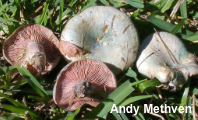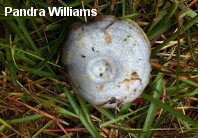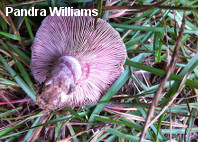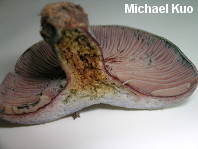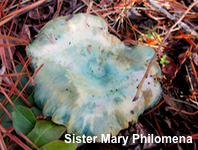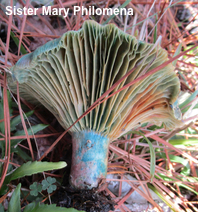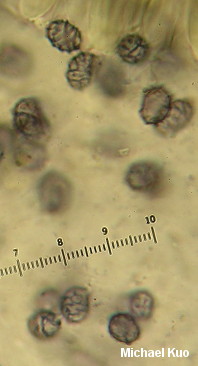| Major Groups > Gilled Mushrooms > Pale-Spored > Lactarius > Lactarius paradoxus |

|
[ Basidiomycota > Russulales > Russulaceae > Lactarius . . . ] Lactarius paradoxus by Michael Kuo, 12 September 2023 Henry Beardslee and Gertrude Burlingham named Lactarius paradoxus in 1940, mentioning in comments that the species looks like Lactarius indigo "when viewed from above . . . but upon looking at the under side one is surprised to find it closely resembles Lactaria subpurpurea" (now known as Lactarius subpurpureus). While this contradiction does not constitute a "paradox" in modern English, the Greek root simply means "odd," which is accurate; the species does look like an indigo-subpurpureus combination, depending on how you hold it. Lactarius paradoxus is more easily identified when young, when it features a blue cap with a silvery sheen, and purplish pink gills. As it matures, however, the species develops drab buff and tan shades, and begins to stain and discolor dirty green, making it less clearly distinct from older specimens of Lactarius subpurpureus and Lactarius chelidonium. However, the former is exclusively associated with eastern hemlock, while the latter has yellowish to brownish latex. Thanks to Pandra Williams, Roxanne Palmrose, and Sister Mary Philomena for collecting, documenting, and preserving Lactarius paradoxus for study; their collections are deposited in The Herbarium of Michael Kuo. Thanks to Andy Methven for facilitating study of Lactarius paradoxus. Description: Ecology: Mycorrhizal with pines (especially loblolly pine and long-leaf pine); growing alone or gregariously, often in grassy areas near the host trees; summer and fall; originally described from Florida (Beardslee & Birmingham 1940); fairly widely distributed in eastern North America, but more common in the lower Appalachians and the southeastern states; also recorded from the Caribbean and the Gulf Coast of Mexico. The illustrated and described collections are from Arkansas, Georgia, Florida, and Texas. Cap: 4–13 cm; broadly convex with a slightly tucked-under margin when young; becoming centrally depressed, with an uplifted margin, or shallowly vase-shaped; slimy when fresh; bald; dark blue to bluish, with a silvery sheen when young, becoming dirty grayish to purplish tan; often with faint to moderate concentric zones of color; with old age staining dirty green and eventually becoming sordid bluish green overall. Gills: Broadly attached to the stem or just beginning to run down it; close; short-gills present; purplish pink when young, becoming dirty buff to orangish with maturity; staining and bruising dirty green. Stem: 2–5 cm long; 1–1.5 cm thick; usually tapered to the base; bald; without potholes; dry; colored like the cap, but with purplish pink flushes—or purplish pink overall; staining dirty green with age; hollowing. Flesh: Whitish to bluish, greenish, or purplish (or brownish in the mature, hollowing stem); firm; staining purplish red in places when sliced. Milk: Very scant; dark purplish red; staining surfaces purplish red. Odor and Taste: Not distinctive. Spore Print: Pale yellowish. Microscopic Features: Spores 7–10 x 5.5–6.5 µm; ellipsoid; ornamentation consisting of amyloid warts and ridges extending 0.5–0.75 µm high, forming partial reticula. Hymenial macrocystidia rare; to about 60 µm long; mucronate; scarcely projecting. Pileipellis a thick ixocutis. REFERENCES: H. C. Beardslee & G. S. Burlingham, 1940. (Hesler & Smith, 1979; Smith, Smith & Weber, 1979; Weber & Smith, 1985; Lincoff, 1992; Metzler & Metzler, 1992; Montoya et al., 1998; McNeil, 2006; Miller & Miller, 2006; Elliott & Stephenson, 2018.) Herb. Kuo 10161301, 12101507, 11242001 (portion of ASM 12505), 12172203. Herb ILLS ASM 13861. This site contains no information about the edibility or toxicity of mushrooms. |
© MushroomExpert.Com |
|
Cite this page as: Kuo, M. (2023, September). Lactarius paradoxus. Retrieved from the MushroomExpert.Com Web site: http://www.mushroomexpert.com/lactarius_paradoxus.html |
